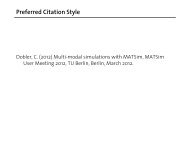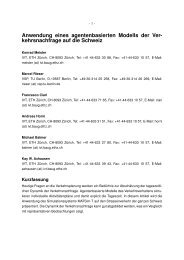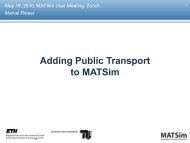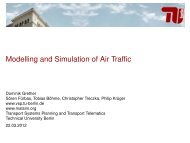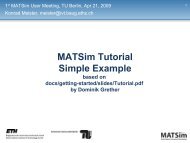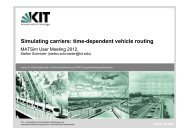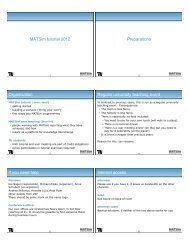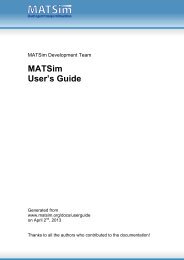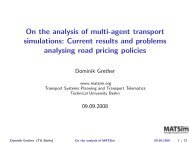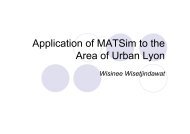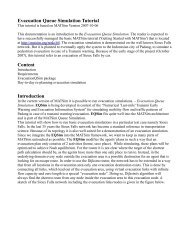LARGE-SCALE PARALLEL GRAPH-BASED SIMULATIONS - MATSim
LARGE-SCALE PARALLEL GRAPH-BASED SIMULATIONS - MATSim
LARGE-SCALE PARALLEL GRAPH-BASED SIMULATIONS - MATSim
Create successful ePaper yourself
Turn your PDF publications into a flip-book with our unique Google optimized e-Paper software.
5. The receiver must unpack the message and tell the computer where to store the received<br />
data.<br />
There are time delays associated with each of these phases. It is important to note that some<br />
of these time delays are incurred even for an empty message (“latency”), whereas others depend<br />
on the size of the message (“bandwidth restriction”). Effects of time delays are explained in<br />
Section 4.4.<br />
4.1.2 Domain Decomposition<br />
On PC clusters, two general strategies are possible for parallelization of data domains:<br />
Task parallelization – The different modules of a transportation simulation package<br />
(traffic flow simulation, routing, activities generation, learning, pre-/postprocessing) are<br />
run on different computers. This approach is for example used by DynaMIT [17] or<br />
DYNASMART [18].<br />
The advantage of this approach is that it is conceptually straightforward, and fairly insensitive<br />
to network bottlenecks. The disadvantage of this approach is that the slowest<br />
module will dominate the computing speed – for example, if the traffic flow simulation<br />
among different modules is using up most of the computing time, then task parallelization<br />
of the modules will not help.<br />
Domain decomposition – In this approach, each module is distributed across several<br />
CPUs. In fact, for most of the modules, this is straightforward since in current practical<br />
implementations activity generation, route generation, and learning are done for each<br />
traveler separately. Only traffic flow simulation has tight interaction between the travelers<br />
as explained in the following.<br />
For PC clusters, the most costly communication operation is the initiation of a message<br />
(“latency”). In consequence, the number of CPUs that need to communicate with each other<br />
should be minimized. This is achieved through a domain decomposition (see Figure 4.2) of the<br />
traffic network graph. As long as the domains remain compact, each CPU will, on average, have<br />
at most six neighbors (Euler’s theorem for planar graphs). Since network graphs are irregular<br />
structures, a method to deal with this irregularity is needed. METIS [91] is a software package<br />
that specifically deals with decomposing graphs for parallel computation and is explained in<br />
more detail in Section 4.3.1.<br />
The quality of the graph decomposition has consequences for parallel efficiency (load balancing):<br />
If one CPU has a lot more work to do than all other CPUs, then all other CPUs are<br />
¡ ¢ ¢<br />
obliged to wait for it, which is inefficient. For the current work with CPUs and networks<br />
¢ ¢ ¢ ¢<br />
with links, the “latency problem” (explained in Section 4.4) always dominates load<br />
balancing issues; however it is generally useful to employ the actual computational load per<br />
network entity for the graph decomposition [57].<br />
For shared memory machines, other forms of parallelization are possible, based on individual<br />
network links or individual travelers. A dispatcher could distribute links for computation<br />
in a round-robin fashion to the CPUs of the shared memory machine [31]; technically, threads<br />
[72] would be used for this. This is be called fine-grained parallelism, as opposed to the coarsegrained<br />
parallelism, which is more appropriate for message passing architectures. As stated<br />
above, the main drawback of this method is that one needs an expensive machine if one wants<br />
to use large numbers of CPUs.<br />
39



